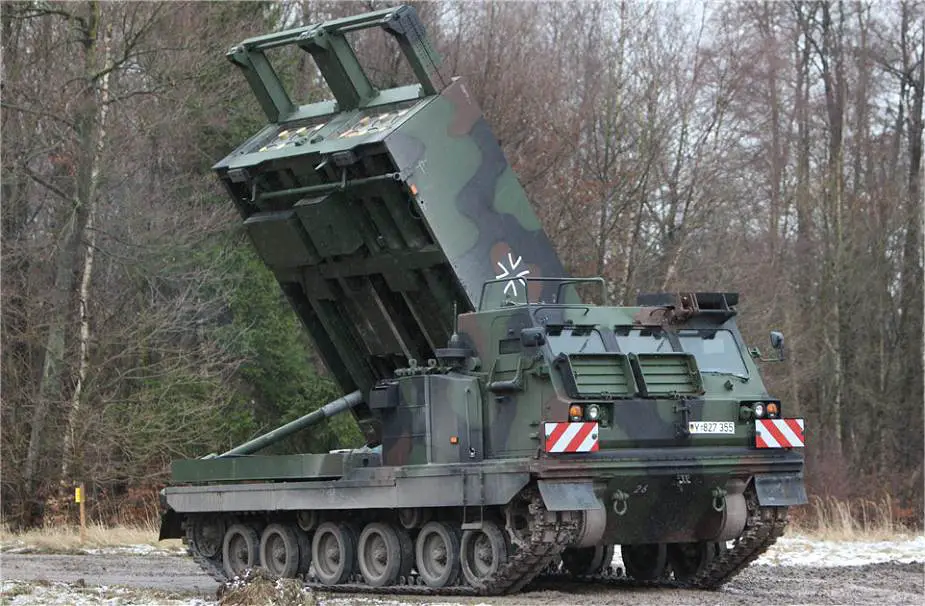German army MARS II MLRS-E improved Multiple Launch Rocket System artillery sniper weapon
German army continues to use the American M270 MLRS, Multiple Launch Rocket System that entered in service with the U.S. Army in 1983. The German version has now been upgraded to the standard MARS II/MLRS-E able to fire guided rockets. The M270 is also in service with Egypt, Bahrain, Finland, France, Greece, Israel, Italy, Japan, Saudi Arabia, South Korea, Turkey, and the UK.
Follow Army Recognition on Google News at this link

German army MARS II/MLRS-E Multiple Launch Rocket System. (Picture source KMW)
The M270 MLRS (Multiple Launch Rocket System) is in service with the German army since 1990 under the name of MARS (Medium Artillery Rocket System). The vehicle is based on a stretched version of the American Bradley tracked armored IFV (Infantry Fighting Vehicle). The vehicle design consists of a crew cab located at the front of the chassis and the launcher unit mounted at the rear of the tracked chassis It contains the computerized fire-control system, a stabilization reference package/position determining system, a launcher drive system, and a twin-boom crane unit for self-loading and unloading.
The original launcher unit of the M270 is fitted with two pods of six launcher tubes able to fire unguided 230 mm rockets in approx. 60 seconds. In November 1998, American company Lockheed Martin Missiles and Fire Control was awarded a contract for the development of the Guided MLRS (GMLRS) rocket. The GMLRS was an international cooperative program with France, Germany, Italy, the UK, and the US who worked together throughout the EMD phase of the rocket's life cycle. The GMLRS rocket includes an Inertial Measurement Unit (IMU) aided by a Global Positioning System (GPS) integrated on a GMLRS rocket body. The MARS II of the German army is now equipped with a new European Fire Control System (EFC) enabling the firing of guided missiles GMLRS. It can also fire M31 GMLRS, M31A1, M32, AT2 and 110 mm rockets, but not of M26, M26A1, and M30, so as to ensure full compliance with the Convention on Cluster Munitions.
The MARS II/MLRS-E has a crew of three including the driver, commander and gunner which are seated in the fully enclosed cab at the front of the vehicle offering protection against the firing of small arms and artillery shell fragments by aluminum armor and louvered windows. All the firing operations can be performed from inside of the crew cabin which is fitted with an overpressure ventilation system to prevent rocket fumes from entering the cab. Equipment capabilities permit a reduced crew, or even one person, to accomplish a complete fire mission including the loading and unloading operations.

The GLMRS is GPS guided rocket able to reach a target of up to 70 km. (Picture source Lockheed Martin)
The GMLRS was developed to provide new precision strike capability in urban and complex terrain. The rocket is fitted with an improved guidance system allowing precision strikes. It incorporates a new differential global positioning system with an antenna that has greater resistance to jamming. The CEP (Circular Error Probable) has been improved from 10 m on the standard GMLRS to about 2 m on the unitary warhead variant.
The M31 had a dual-mode fuse with point detonation and delay options to defeat soft targets and lightly fortified bunkers respectively, with the upgraded M31A1 equipped with a multi-mode fuse adding a proximity airburst mode for use against personnel. The rocket has a minimum engagement range of 15 km and can hit a target up to 70 km. It also integrates a 90 kg unitary warhead, providing precision strikes for point targets.
American company Lockheed Martin has also developed the Guided MLRS AW (Alternative Warhead) round, the first munition developed to service area targets without the effects of unexploded ordnance, complying with the U.S. Department of Defense cluster munitions policy and international policies. The AW variant has a range exceeding 70 km and delivers a 90 kg class fragmenting warhead. A new developmental variation of the Guided MLRS family, ER (Extended Range) GMLRS offers an extended range out to 150 km in all weather conditions. ER GMLRS shares significant commonality with legacy Guided MLRS and is deployable by HIMARS and the MLRS M270 family of rocket launcher vehicles. The rounds incorporate a larger motor and have enhanced maneuverability due to tail-driven control.
The upgraded MARS II/MLRS-E with the new GMLRS is now able to conduct high-precision engagement of point and individual targets and used as an artillery sniper weapon. The modernized variant of the M270 is also in service with Italy under the name of improved MLRS and in France as "Lance Roquette Unitaire (LRU)".
The obsolete hydraulic laying drives have been replaced by an electric laying system (Electrical Launch Drive System – ELDS) developed by German company KMW (Krauss-Maffei Wegmann), which enables rapid laying and reduces maintenance and repair effort as compared to the hydraulic system. The vehicle is also fitted with fully automatic halon and CFC-free fire extinguishing system which uses nitrogen as the extinguishing agent for the engine compartment. It enables automatic fire monitoring and fighting, even up to 24 hours after the MARS II/MLRS-E launcher has been shut down. This retrofit package is –unlike the other two upgrade measures – currently only used in Germany and Italy.
The MARS II/MLRS-E is motorized with a Cummins VTA-903 turbo-charged 8-cylinder diesel engine developing 500 hp at 2,400 rpm coupled to General Dynamics Land Systems HMPT-500 hydro-mechanical transmission. It can run at a maximum road speed of 64 km/h with a maximum cruising range of 483 km.


























